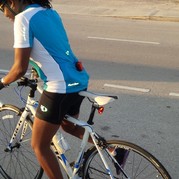
There are three distict types of muscle fibre, type I which are slow twitch, type IIa and type IIb which are fast twitch. The percentage of each varies from person to person, and from one muscle to another in the same person. There is a fourth type of muscle fibre - type IIc is also a fast twitch fibre that results from the fusion of type IIb with surrounding satelite cells.
Activities That Use the Different Types of Muscle Fibres
A type of activity that primarily utilizes type one muscle fibers is marathon running. These types of muscle fibers are characterized as being the slow twitch oxidative muscle fibers. They contract slowly, they have the highest tolerance to fatigue as compared to the other types of muscle fibers, and their main fuel source tends to be triglycerides. As such, the best way to train this type of muscle fiber would be with low intensity endurance type exercises.
The typical body type of individuals who regularly perform this type of activity is the ectomorphic or slim, linear body type. In order to affect the greatest number of those muscle fibers, one would need to train with higher reps, shorter rest periods and higher volume. This is because they take longer to fatigue, they recover quickly and they require more work to maximize growth.
Activities That Use the Different Types of Muscle Fibres
A type of activity that primarily utilizes type one muscle fibers is marathon running. These types of muscle fibers are characterized as being the slow twitch oxidative muscle fibers. They contract slowly, they have the highest tolerance to fatigue as compared to the other types of muscle fibers, and their main fuel source tends to be triglycerides. As such, the best way to train this type of muscle fiber would be with low intensity endurance type exercises.
The typical body type of individuals who regularly perform this type of activity is the ectomorphic or slim, linear body type. In order to affect the greatest number of those muscle fibers, one would need to train with higher reps, shorter rest periods and higher volume. This is because they take longer to fatigue, they recover quickly and they require more work to maximize growth.

To train the body to better perform this activity we could use low intensity, aerobic training and when lifting weights, you want to work as many muscle fibers as you can as this results in greater gains in strength and mass. Lifting with higher reps, shorter rest periods and higher volume is best suited for slow twitch muscle fibers, because these muscle fibers take longer to fatigue and can recover quicker. They also require more work for muscle growth, but due to the fiber type are limited in the potential growth. So for Type I fibers it is also important to involve some low rep lifting to maximize those fast twitch fibers that are present.
Type IIa muscle fibers also known as fast twitch intermediate fibers are large in size and much stronger than type 1 fibers. Fast twitch fibers are known for their ability to rapidly transmit action potentials and generate a high cross-bridge turnover rate (responsible for quick muscle contractions). One activity suited for this muscle fiber type is weight lifting, these fibers generate an explosive burst of power for a short period of time. They rely heavy on the glycolytic energy pathway, and are in the middle of the muscle fiber spectrum, as they are less fatigue resistance, produce more muscular force, and contract at a faster speed than slow twitch fibers.
The typical body type of persons who regularly perform weight lifting is the mesomorphic or muscular body type. To train for this activity we must bear in mind that during any muscular contraction, type I fibers are activated first. If the type I fibers are not strong enough to get the job done, type IIa fibers and then type IIb fibers are called upon. Therefore type IIa fibers and especially type IIb fibers are only recruited if the intensity is sufficient enough. A good exercise that utilizes this muscle fiber would be cable press, the set should be performed with enough weight so that you are maxed out on reps after 20 to 70 seconds. The power in this exercise comes from the challenge of doing presses with controlled speed. You'll do cable chest presses quickly with two single cables, engaging your legs and core to maintain a stable upper body position, ultimately this exercise will benefit the body builder who wants to strengthen and increase the size of their chest, legs and core.
The type IIb fibers are the most easily fatigued out of all the fibers but also generate the most power. These are most heavily recruited for activities that require an all out burst of power over a very short period of time. The body type that utilizes these muscles ae predominantly mesomorphic, however they can have a mix of both mesomorphic and ectomorphic.
An example of an activity that would utilize this muscle fiber is tennis. If you are a tennis player, then for your cross court sprints or power shots you are doing some major recruitment of 2B fibers. Therefore, in your workouts you should be focusing on power trunk rotations for power shots and full-speed, two to three-second side shuffles for runs.
Reference - Fitness: The Complete Guide
Type IIa muscle fibers also known as fast twitch intermediate fibers are large in size and much stronger than type 1 fibers. Fast twitch fibers are known for their ability to rapidly transmit action potentials and generate a high cross-bridge turnover rate (responsible for quick muscle contractions). One activity suited for this muscle fiber type is weight lifting, these fibers generate an explosive burst of power for a short period of time. They rely heavy on the glycolytic energy pathway, and are in the middle of the muscle fiber spectrum, as they are less fatigue resistance, produce more muscular force, and contract at a faster speed than slow twitch fibers.
The typical body type of persons who regularly perform weight lifting is the mesomorphic or muscular body type. To train for this activity we must bear in mind that during any muscular contraction, type I fibers are activated first. If the type I fibers are not strong enough to get the job done, type IIa fibers and then type IIb fibers are called upon. Therefore type IIa fibers and especially type IIb fibers are only recruited if the intensity is sufficient enough. A good exercise that utilizes this muscle fiber would be cable press, the set should be performed with enough weight so that you are maxed out on reps after 20 to 70 seconds. The power in this exercise comes from the challenge of doing presses with controlled speed. You'll do cable chest presses quickly with two single cables, engaging your legs and core to maintain a stable upper body position, ultimately this exercise will benefit the body builder who wants to strengthen and increase the size of their chest, legs and core.
The type IIb fibers are the most easily fatigued out of all the fibers but also generate the most power. These are most heavily recruited for activities that require an all out burst of power over a very short period of time. The body type that utilizes these muscles ae predominantly mesomorphic, however they can have a mix of both mesomorphic and ectomorphic.
An example of an activity that would utilize this muscle fiber is tennis. If you are a tennis player, then for your cross court sprints or power shots you are doing some major recruitment of 2B fibers. Therefore, in your workouts you should be focusing on power trunk rotations for power shots and full-speed, two to three-second side shuffles for runs.
Reference - Fitness: The Complete Guide

 RSS Feed
RSS Feed